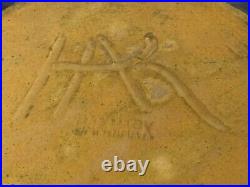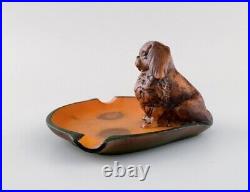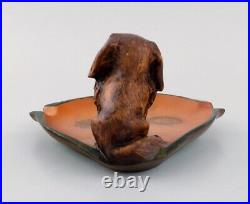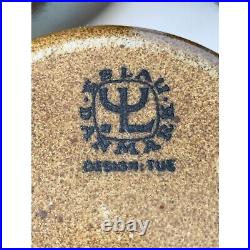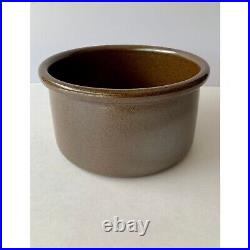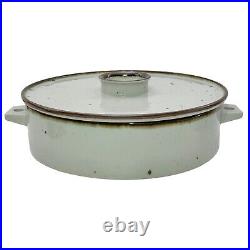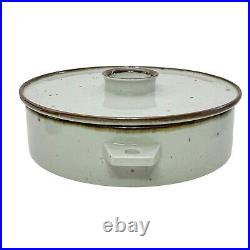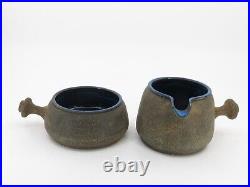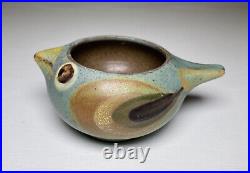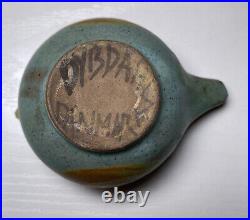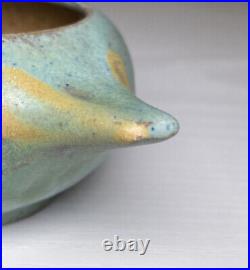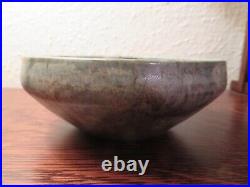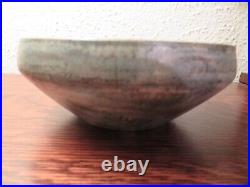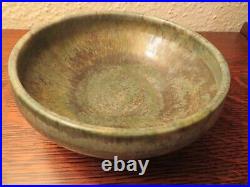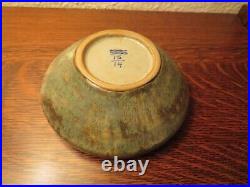Posts tagged denmark
2 Ady Kroyer Johansen Pottery Bowls. Pair of folk art style pottery bowls each with a dancing couple and a musician. The signed mid century bowls were made by Ady Kroyer Johansen of Denmark. The oval bowls are 8 1/2″ by 6 3/4″. They are 2 1/2 tall at the higher sides. One bowl has a chip on the rim and a couple glaze flakes on the base. The other has some glaze pits in the center and scratches on the exterior. The bowls have light wear and some marks mainly along the rims. The exterior has a metallic finish which is spotty in some areas.
Add a touch of vintage charm to your home decor with this beautiful Danish round earthenware bowl. Crafted by the renowned Herman Kahler, of Denmark, the bowl features a lovely blue swirl pattern that is sure to catch anyone’s eye. Made from high-quality earthenware material, this bowl is both durable and aesthetically pleasing. Perfect for serving or as a decorative piece, this bowl comes with a lid and is ideal for a variety of occasions. Whether you’re hosting a dinner party or simply looking to add a unique touch to your home, this Herman Kahler bowl is the perfect choice. Add it to your collection today! This is a nice Vintage Herman Kähler Round Earthenware Bowl with Blue Swirl Pattern. The dimensions of this piece are 6 3/4″ wide x 3 1/4″ tall.
2 Ady Kroyer Johansen Pottery Bowls. Pair of folk art style pottery bowls each with a dancing couple and a musician. The signed mid century bowls were made by Ady Kroyer Johansen of Denmark. The oval bowls are 8 1/2″ by 6 3/4″. They are 2 1/2 tall at the higher sides. One bowl has a chip on the rim and a couple glaze flakes on the base. The other has some glaze pits in the center and scratches on the exterior. The bowls have light wear and some marks mainly along the rims. The exterior has a metallic finish which is spotty in some areas.
Pair of Vintage Modernist Stoneware Pottery Vessels Signed Nils Kahler, Denmark A wonderful pair of vintage vessels, a creamer and one sugar bowl with handles Creamer dimensions: 4.75″ wide x 2.75″ tall Sugar bowl: 5″ wide x 1.75″ tall Condition: Very good condition pair that are free from cracks or repairs — do note one small rim chip to the sugar bowl and some light marks to the base rim. Please see pictures showing item details and condition.
Vintage Denmark Dybdahl Studio Pottery Bird Salt Cellar / Egg Cup Danish MCM. There are no obvious chips or cracks. On the tip of the tail there is a small spot (photos 12 & 8) that is slightly rough, but it’s hard to tell if it was created during production or afterwards. Both sides of the tail are slightly lighter in color. If you have any additional questions or need additional photos, please let me know. Please review all photos before purchasing. This item is in the category “Pottery & Glass\Decorative Cookware, Dinnerware & Serveware\Bowls”. The seller is “212gold” and is located in this country: US. This item can be shipped to United States, all countries in Europe, Japan, Canada.
- Origin: Denmark
- Pattern: Vintage
- Occasion: All Occasions
- Color: Multicolor
- Material: Clay
- Set Includes: Cup
- Vintage: Yes
- Brand: Vtg Danish Dybdahl Studio Pottery
- Type: Cup
- Original/Licensed Reproduction: Original
- Theme: Birds
- Style: Mid-Century Modern
- Features: Hand Painted
- Production Style: Art Pottery
- Production Technique: Pottery
- Backstamp: Painted
- Country/Region of Manufacture: Denmark
- Handmade: Yes
Royal Copenhagen Stoneware: Carl Halier attrib. , Denmark, Footed Bowl, 1920s. It was really only with the arrival in 1911 at Royal Copenhagen of the Swede Patrick Nordstr. Patrick Nordström was born in. Väsby, outside Höganäs, a major Swedish pottery center. He was the son of a master carpenter and trained as a woodcarver and sculptor. After completing his studies in Stockholm, he spent five years traveling in Europe, starting in Berlin and going on to Venice and Paris. Before leaving Paris, he. Worked as a stucco and ornament sculptor in the construction of buildings for the 1900 Paris Exhibition Universelle, where he is reported to have been impressed by the work of a new generation of French stoneware artists, including Carries, Chaplet, Delaherche and Dalpayrat. Inspired and determined to bring the art of stoneware manufacture to Denmark. Nordström took up residence in Copenhagen, where he initially resumed his profession as an ornament sculptor. In his spare time he began to experiment with ceramic works, a field in which he was entirely self-taught, in a self-built kiln in the basement of his home in Fredriksberg. In 1911, he produced his first pieces in stoneware in a kiln in the garden of his villa in Vanl. Se, where he also fired works for other artists, including Knud Kyhn and J. Nordström drew his inspiration from the Chinese and Japanese influences on French stoneware artists. Nordström’s production soon attracted the interest of Arnold Krog at Royal Copenhagen, and he began work there in 1912, initially to develop stoneware glazes. He was to remain at Royal Copenhagen for ten years, eventually assuming overall responsibility for its stoneware production. Nordström left Royal Copenhagen in 1922 to establish his own workhop in Islev, but only after leaving a legacy of technical innovation in glazes, his own body of studio stoneware inspired by Japanese and Chinese art, and a group of trained collaborators to carry on Royal Copenhagen’s stoneware tradition. His matte crystaline glazes, inspired by those developed in the far east, were continued and perfected by fellow Royal Copenhagen artists Carl Halier, Axel Salto and Nils Thorsson. This elegant footed bowl is very characteristic of Royal Copenhagen stoneware in the Patrick. In the case of this piece, my best guess on dating and attribution is that this is a 1920s era piece from the hand of Carl Halier. The glaze on this piece is a beautiful mottled matte in a soft grayish-greenish blue with brown tones coming through. The piece is well marked with the hand-painted three blue waves and the sort of numbering (15/14) frequently found on Carl Halier pieces in the 1910s and 1920s. The dimensions of this bowl are approximately 6.25 inches across the rim, flaring from a bit less than 3 inches at the foot, and 2.25 inches high. This first quality piece is in excellent original condition, with no observed flaws. Please see the photos for further details on condition and to fully appreciate this bowl’s glaze and form. The bulk of my collection is Danish stoneware from the 1920s into the 1970s. The bulk of my Danish collection consists of Arne Bang, Saxbo, Jais Nielsen, Nils Thorsson, Erik Hjorth, and Ejvind Nielsen. I have done extensive research on these and other artists and workshops and would be happy to share that with interested buyers. I also have substantial collections of American, French, Belgian and other 20th century northern European art pottery. Over the coming months I will be listing a wide range of pieces from my collection. Please check out my other listings and add me to your list of saved sellers to receive notification of new listings. This item is in the category “Pottery & Glass\Decorative Cookware, Dinnerware & Serveware\Bowls”. The seller is “potsandplates” and is located in this country: US. This item can be shipped to United States.
- MPN: 15/14
- Handmade: Yes
- Time Period Manufactured: 1920-1929
- Production Technique: Pottery
- Vintage: Yes
- Era: Early 20th Century (1911-1940)
- Country/Region of Manufacture: Denmark
- Origin: Denmark
- Material: Stoneware
- Year Manufactured: 1920
- Model: Attributed to Carl Halier
- Shape: Footed Bowl
- Finish: Matte
- Production Style: Art Pottery
- Brand: Royal Copenhagen
- Style: Art Deco
- Antique: No
- Color: Multi-Color
- Signed: Yes
- Original/Licensed Reproduction: Original
- Type: Bowl
- Original/Reproduction: Vintage Original































